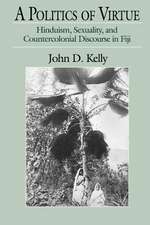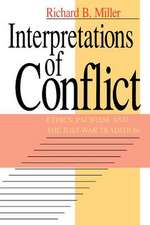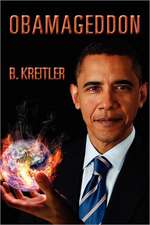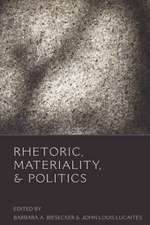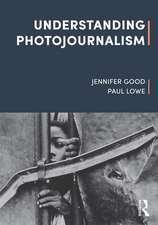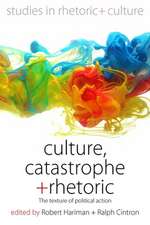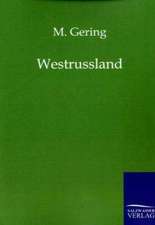No Caption Needed: Iconic Photographs, Public Culture, and Liberal Democracy: Emersion: Emergent Village resources for communities of faith
Autor Robert Hariman, John Louis Lucaitesen Limba Engleză Hardback – iun 2007
Arguing against the conventional belief that visual images short-circuit rational deliberation and radical critique, Hariman and Lucaites make a bold case for the value of visual imagery in a liberal-democratic society. No Caption Needed is a compelling demonstration of photojournalism’s vital contribution to public life.
| Toate formatele și edițiile | Preț | Express |
|---|---|---|
| Paperback (1) | 202.17 lei 3-5 săpt. | +22.68 lei 4-10 zile |
| University of Chicago Press – 30 mai 2011 | 202.17 lei 3-5 săpt. | +22.68 lei 4-10 zile |
| Hardback (1) | 400.50 lei 6-8 săpt. | |
| University of Chicago Press – iun 2007 | 400.50 lei 6-8 săpt. |
Din seria Emersion: Emergent Village resources for communities of faith
-
 Preț: 144.99 lei
Preț: 144.99 lei -
 Preț: 133.99 lei
Preț: 133.99 lei - 9%
 Preț: 352.50 lei
Preț: 352.50 lei -
 Preț: 146.50 lei
Preț: 146.50 lei -
 Preț: 208.32 lei
Preț: 208.32 lei -
 Preț: 156.84 lei
Preț: 156.84 lei -
 Preț: 115.53 lei
Preț: 115.53 lei -
 Preț: 548.71 lei
Preț: 548.71 lei - 8%
 Preț: 346.31 lei
Preț: 346.31 lei - 8%
 Preț: 360.28 lei
Preț: 360.28 lei -
 Preț: 216.90 lei
Preț: 216.90 lei -
 Preț: 101.43 lei
Preț: 101.43 lei -
 Preț: 215.52 lei
Preț: 215.52 lei -
 Preț: 185.37 lei
Preț: 185.37 lei - 8%
 Preț: 563.24 lei
Preț: 563.24 lei -
 Preț: 179.04 lei
Preț: 179.04 lei -
 Preț: 106.35 lei
Preț: 106.35 lei -
 Preț: 138.81 lei
Preț: 138.81 lei -
 Preț: 273.93 lei
Preț: 273.93 lei -
 Preț: 127.89 lei
Preț: 127.89 lei - 9%
 Preț: 353.24 lei
Preț: 353.24 lei -
 Preț: 176.49 lei
Preț: 176.49 lei -
 Preț: 94.22 lei
Preț: 94.22 lei -
 Preț: 144.80 lei
Preț: 144.80 lei -
 Preț: 126.25 lei
Preț: 126.25 lei -
 Preț: 67.35 lei
Preț: 67.35 lei -
 Preț: 163.52 lei
Preț: 163.52 lei -
 Preț: 138.26 lei
Preț: 138.26 lei -
 Preț: 182.98 lei
Preț: 182.98 lei - 18%
 Preț: 502.35 lei
Preț: 502.35 lei - 18%
 Preț: 2261.34 lei
Preț: 2261.34 lei -
 Preț: 279.55 lei
Preț: 279.55 lei -
 Preț: 116.07 lei
Preț: 116.07 lei -
 Preț: 208.55 lei
Preț: 208.55 lei -
 Preț: 167.85 lei
Preț: 167.85 lei -
 Preț: 160.63 lei
Preț: 160.63 lei -
 Preț: 183.89 lei
Preț: 183.89 lei - 9%
 Preț: 352.77 lei
Preț: 352.77 lei -
 Preț: 307.55 lei
Preț: 307.55 lei - 12%
 Preț: 290.56 lei
Preț: 290.56 lei - 8%
 Preț: 311.68 lei
Preț: 311.68 lei -
 Preț: 120.81 lei
Preț: 120.81 lei -
 Preț: 229.92 lei
Preț: 229.92 lei - 6%
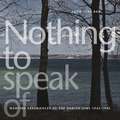 Preț: 324.95 lei
Preț: 324.95 lei -
 Preț: 145.41 lei
Preț: 145.41 lei -
 Preț: 152.07 lei
Preț: 152.07 lei -
 Preț: 186.09 lei
Preț: 186.09 lei - 18%
 Preț: 348.59 lei
Preț: 348.59 lei -
 Preț: 302.76 lei
Preț: 302.76 lei - 8%
 Preț: 565.01 lei
Preț: 565.01 lei
Preț: 400.50 lei
Nou
Puncte Express: 601
Preț estimativ în valută:
76.63€ • 80.02$ • 63.28£
76.63€ • 80.02$ • 63.28£
Carte tipărită la comandă
Livrare economică 15-29 aprilie
Preluare comenzi: 021 569.72.76
Specificații
ISBN-13: 9780226316062
ISBN-10: 0226316068
Pagini: 432
Ilustrații: 53 halftones
Dimensiuni: 152 x 229 x 33 mm
Greutate: 0.79 kg
Editura: University of Chicago Press
Colecția University of Chicago Press
Seria Emersion: Emergent Village resources for communities of faith
ISBN-10: 0226316068
Pagini: 432
Ilustrații: 53 halftones
Dimensiuni: 152 x 229 x 33 mm
Greutate: 0.79 kg
Editura: University of Chicago Press
Colecția University of Chicago Press
Seria Emersion: Emergent Village resources for communities of faith
Notă biografică
Robert Hariman is professor of communication at Northwestern University and the author of Political Style: The Artistry of Power. John Louis Lucaites is professor of communication and culture at Indiana University. He is coauthor of Crafting Equality: America’s Anglo-African World.
Cuprins
CONTENTS
LIST OF ILLUSTRATIONS
ACKNOWLEDGMENTS
ACKNOWLEDGMENTS
1
INTRODUCTION
2
PUBLIC CULTURE, ICONS, AND ICONOCLASTS
3
THE BORDERS OF THE GENRE
Migrant Mother and the Times Square Kiss
4
PERFORMING CIVIC IDENTITY
Flag Raisings at Iwo Jima and Ground Zero
5
DISSENT AND EMOTIONAL MANAGEMENT
Kent State
6
TRAUMA AND PUBLIC MEMORY
Accidental Napalm
7
LIBERAL REPRESENTATION AND GLOBAL ORDER
Tiananmen Square
8
RITUALIZING MODERNITY’S GAMBLE
The Hindenburg and Challenger Explosions
9
CONCLUSION
Visual Democracy
NOTES
INDEX
Recenzii
"Through outstanding studies of specific iconic images, Hariman and Lucaites address powerfully the emotional resonance and political complexity of photojournalism. They demonstrate how the collective response to photographs can reveal national and cultural character. Their discussion of these themes is a service and tribute to all those who care about visual communication. Photojournalists and citizens alike can learn a great deal from this terrific book."
“This authoritative, thought-provoking book analyzes the genesis and reception of key American images from Dorothea Lange's 'Migrant Mother' to pictures of the Challenger disaster and 9/11. Drawing extensively on the recent scholarly literature, it demonstrates the pivotal position of the still photograph in modern visual culture. It will be essential reading for students of 20th-century photojournalism, propaganda and mass media. Highly recommended.”
“I was truly astounded by the intelligence of the analyses in No Caption Needed, and the authors’ refusal to either over- or underestimate the power of these iconic images. Beyond that, Hariman and Lucaites engage in a profound reflection on the role of iconic journalistic photographs in modern democratic societies, the way they become ideological totems, or provocatives to further controversy. This book will be the starting point for any future attempt to deal with the problem of the iconic photograph and its social uses.”--W. J. T. Mitchell, author of What Do Pictures Want?
“No Caption Needed is a fascinating study of why a photograph is successful and what happens to that image once it enters America's collective conscious as an icon. Hariman and Lucaites’s exhaustively researched book provides thoughtful insight into how some photographs have helped shape America's cultural identity, and explains how one image can be used by different parties to fulfill different agendas. I recommend this book to anybody interested in the history and development of visual culture in the United States.”
“A penetrating and provocative analysis. . . . The authors’ analytical achievement is enabled by an extraordinary feat of research and reporting.”--James Rosen, The American Interest
"An admirable study."
"What especially distinguishes this work is the authors' discussion of the myriad ways iconographic photographs are used, transformed, and appropriated, thereby creating a dynamic rhetorical presence that continues to influence memory, thought, and behavior."
"Historians of photography will want to read No Caption Needed not only for its insightful examination of individual photographs but also for its sophisticated analysis of the role of photography in a democratic society."
"[The authors] make an eloquent and compelling case, in print, for the centrality of the photographic icon to American cultural debate."
James A. Winans-Herbert A. Wichelns Memorial Award for Distinguished Scholarship in Rhetoric and Public Address
"[The book] provides a dynamic and much-needed contribution to debates concerning the value of visual representation and its relationship to implicit tensions within liberal democracy. The book arrives on the heels of current efforts within an expanding field of visual studies to push for full understanding of the technological and cultural (and not strictly textual) processes through which meanings are made for images."





